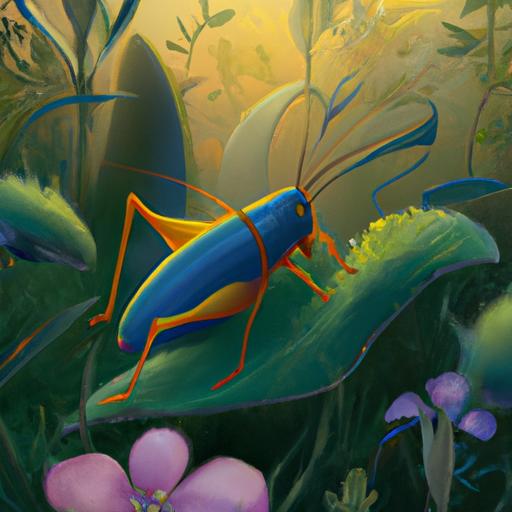Have you ever heard the chirping of crickets in the evening? Many of us are familiar with the eerie sound of these small insects, but how much do you actually know about them? From their diet to their sleeping habits, there are some surprising facts about crickets that you may not know. In this article, well explore the nocturnal nature of crickets and answer questions like: what are crickets, why are they nocturnal, what do they eat, and where do they live? We’ll also cover the unique sounds that crickets make and how they survive in the wild, as well as what animals prey on them. Read on to learn more about these fascinating creatures!
Table of Contents
Short Answer
Most crickets are nocturnal, meaning they are most active at night.
This is an adaptive behavior that helps them avoid predators during the day.
Different species of crickets may be more active during the day or night depending on their habitat and the amount of light available.
Some species of crickets, such as the snowy tree cricket, are active during both the day and night.
What Are Crickets?
Crickets are small insects that belong to the order Orthoptera and the family Gryllidae.
They are found all over the world, and there are over 900 species of crickets that have been identified.
Crickets vary in size, color, and shape, but all of them have long antennae and powerful hind legs that they use to jump and hop around.
While many people associate crickets with the sound they make, there are actually several different types of crickets, including silent, singing, and burrowing species.
Crickets are a type of omnivore, meaning they will feed on a variety of plant and animal material, including insects, small mammals, and fruits.
Why Are Crickets Nocturnal?

Crickets are nocturnal, meaning they are active at night and sleep during the day.
This is due to their natural behavior, which is to avoid predators and extreme temperatures.
During the day, crickets find shelter in dark, damp places and come out at night to search for food.
This is why you are most likely to hear crickets chirping in the evenings or on cloudy days, when the air is cooler.
Crickets have evolved to be nocturnal to maximize their chances of survival.
By being active at night, they are less likely to be spotted by predators, and the cooler temperatures in the evening help them conserve energy.
Additionally, crickets are attracted to light, and the darkness of the night allows them to move around without being seen.
The nocturnal behavior of crickets also has ecological benefits.
For one, they are a valuable source of food for other animals, such as birds, reptiles, and mammals.
By emerging at night, crickets provide these animals with a reliable food source.
This helps to keep the food chain in balance, as the crickets that are eaten are replaced by those that reproduce.
In conclusion, crickets are nocturnal because of their natural behavior.
They seek shelter during the day and come out at night to search for food, avoiding predators and extreme temperatures.
This behavior also has important ecological benefits, as crickets are a valuable food source for other animals.
What Do Crickets Eat?
Crickets are omnivores and eat a variety of food sources depending on their species.
They will consume both plants and animals, often preferring smaller insects and other invertebrates.
Crickets also feed on decaying vegetation, fungi, and some fruits.
In the wild, they often scavenge for food, eating whatever is most readily available.
In captivity, crickets can be fed commercial cricket food, as well as vegetables, fruits, grains, and other sources of nutrition.
It is important to provide crickets with a balanced diet to ensure they stay healthy.
In addition to their natural diet, crickets also benefit from supplements.
Vitamin and mineral supplements are important for crickets, as they are not always able to get all the nutrients they need from their food.
Supplements can help crickets grow faster, reproduce more successfully, and live longer.
Crickets are social insects and will often feed together in groups.
They are attracted to light, so they can often be seen feeding around the edges of a light source at night.
Crickets will also feed on the bodies of dead insects and animals, so it is important to keep the area around your crickets clean and free of decaying matter.
Crickets are an important part of the natural food chain, as they provide food for many other animals.
They are also beneficial to humans, as they can help to control pests in gardens and greenhouses.
Crickets are a valuable food source for many species, so it is important to maintain a healthy population of crickets in your area.
Where Do Crickets Live?

Crickets are found in a variety of habitats, from forests and grasslands to deserts and backyards.
They can also live in the cracks and crevices of buildings or underground.
Crickets are usually found in areas with plenty of vegetation, since they use plants for food and shelter.
In addition, some species prefer more humid environments, while others prefer dryer climates.
Crickets are also found in tropical and subtropical regions, where they thrive in warm temperatures and moist conditions.
In temperate climates, crickets are found during the warmer months of the year.
During colder months, they often burrow underground to avoid the cold and emerge in the spring.
Crickets are also known to live around human dwellings, such as garages and basements.
While they are generally considered harmless, they can become a nuisance when they invade homes and yards.
If you find crickets in your home, it’s important to take steps to remove them as soon as possible.
What Sounds Do Crickets Make?
Crickets are well known for their distinctive chirping sound, which is produced by rubbing their wings together.
The males produce the sound to attract females, and they can be heard most frequently in the evenings or on cloudy days when the air is cooler.
The chirp of a cricket is actually a series of pulses or “beats” that are repeated at regular intervals.
Each species of cricket has a unique chirp pattern, which can help scientists identify them.
The male crickets also make a low-pitched “song” as they attract mates.
This song is created by rubbing their wings together at a higher frequency than the chirp.
The song can be heard up to several hundred meters away, which is why crickets are often referred to as the “night singers” of the insect world.
Crickets are also known to make other sounds, such as clicks, buzzes, and trills.
These sounds are usually associated with courtship behavior, territorial disputes, or warning signals.
Some species of crickets can even produce ultrasonic sounds, which are too high-pitched for humans to hear.
Crickets are a valuable source of food for other animals, such as birds, reptiles, and mammals.
Their chirping sound is also enjoyed by humans, and many cultures believe that hearing a cricket’s song brings good luck.
The next time you hear a cricket chirping, take a moment to appreciate the complexity and beauty of the insect’s song.
How Do Crickets Survive?

Crickets are nocturnal creatures, which means they are most active at night.
This is because it helps them to avoid predators, as well as extreme temperatures.
During the day, crickets seek shelter in dark, damp places and come out at night to search for food.
Crickets are most commonly heard chirping in the evenings or on cloudy days, when the air is cooler.
Crickets have a few survival strategies that help them to survive.
One of these is their ability to blend in with their environment.
Crickets have evolved to have a coloration and pattern that helps them to blend in with their surroundings.
This helps to camouflage the cricket from potential predators.
Crickets also have an effective defense system.
When crickets feel threatened, they often chirp loudly to startle their predators.
This loud chirping is also a form of communication, as it can alert other crickets of nearby danger.
Crickets are also known to use their wings to buzz and make sounds that are capable of startling predators.
Crickets also have the ability to jump, which is another way for them to flee from predators.
This jumping ability helps them to escape from predators quickly and efficiently.
Finally, crickets are an important source of food for other animals, such as birds, reptiles, and mammals.
This helps to keep the food chain balanced and ensures that crickets are not overhunted.
Overall, crickets have a variety of strategies that help them to survive in the wild.
Their nocturnal behavior, ability to blend in with their surroundings, loud chirping, and jumping ability all contribute to their ability to survive.
Additionally, their importance in the food chain helps to ensure that they are not overhunted.
What Animals Prey on Crickets?
Crickets may be nocturnal, but that doesn’t mean they don’t have predators.
In fact, there are a variety of animals that prey on crickets, including birds, reptiles, and mammals.
Birds such as owls, hawks, and jays are known to feast on crickets, as well as small mammals such as foxes, rats, and mice.
Reptiles, such as snakes and lizards, also hunt crickets.
In addition, some species of frogs and toads feed on crickets as well.
Crickets are particularly vulnerable to predators at night because they lack the natural camouflage of plants and trees.
As a result, they have adapted to use a variety of strategies to protect themselves from predators.
For example, some species of crickets can emit a loud chirp that can startle predators and alert them to the cricket’s presence.
Additionally, crickets have also developed the ability to jump and fly away from danger quickly.
However, this is not always enough to save them from predators, who can easily outrun them.
Final Thoughts
Crickets are an essential part of the natural environment, and they play an important role in the food chain.
Although they are most active during the night, they can be heard throughout the day, especially on cloudy days.
Now that you know more about crickets and their nocturnal behavior, you can appreciate their presence in your environment and understand how they interact with other animals.
So the next time you hear a cricket chirping, take a moment to appreciate the fascinating species and all the benefits they bring to the environment.

